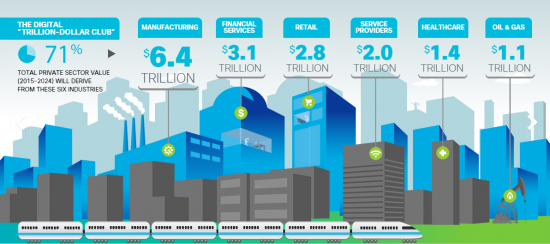































As Cisco's Chief Digital Officer, my entire focus is on enabling Cisco and our customers to accelerate the digitization of our businesses, countries, and cities.
Digitization provides an enormous opportunity to enable, differentiate, and define new business models; yet at its core, the success of the transition is predicated on the capacity to reimagine and reinvent the actual work. This includes building on the Internet foundation to extend the mobility of work, the distribution of work, the immediacy of work, and how and where work will take place.
Being digital isn't just about technology. It requires companies to reexamine their entire way of doing business - and how they offer it - to deliver new value to customers and partners through fast innovation and operational efficiency.
Winners will be those who equate digitization not with basic automation, but instead with the notion of reinventing systems and tools to create a continuous cycle of innovation in a company's product portfolio and operating model.
As we begin 2016, companies are under more pressure to accelerate digitization than ever before.
In fact, according to a 2015 study by the Global Center for Digital Business Transformation (DBT Center), "digital disruption" will displace nearly 4 of the top 10 incumbents by industry over the next five years. The average time to disruption is a mere three years!
In order to build a digitization roadmap, it's important to have a clear sense of the potential value of specific digital investments. To this end, Cisco recently conducted the market's most comprehensive economic analysis to calculate theDigital Value at Stakefor private sector organizations across 16 industries. The analysis is rooted in customer engagements and evaluation of 350 private sector digital use cases.
Digital Value at Stake is based on two components: 1) entirelynew sources of valueemanating from digital investments and innovations, and 2)value shifting among companies and industriesbased on their ability (or inability) to harness digital capabilities (in essence, value moving from "losers" to "winners").
Cisco's analysis shows that six industries - manufacturing, financial services, retail, service provider, healthcare, and oil and gas - will account for 71 percent of the total private sector Digital Value at Stake for the next decade (2015-2024).
Yet, none of these six realized more than 29 percent of its potential Digital Value at Stake in 2015. One of them - retail - managed to capture just 15 percent of its digital value potential last year.

To help retailers close this gap, Cisco has released a report titledA Roadmap to Digital Value in the Retail Industry. It identifies the top 10 sources of digital value for the retail industry, along with a roadmap for getting started and building long-term success.
Retailers need to pay attention: Cisco's analysis shows that a$20 billion retailer that fully embraces digitization has the potential to save$33 million in annual IT costs, and to generate$823 million in annual earnings before interest and taxes (EBIT).
When it comes to digitization, it's important to follow a self-funding strategy that generates both new sources of revenue and operational/IT savings. These gains and savings can then be reinvested in new digital solutions to drive continuous innovation.
Starbucks provides a textbook example of this approach.
An early pioneer in developing its own mobile payment app, Starbucks went one step further by linking the payment app to its customer loyalty program.
The company then decided to address a new customer concern: "line anxiety." Starbucks built on the prior success of its mobile payment app by creating Mobile Order & Pay (MOP). The app allows customers to preorder and pay for their beverages, skipping the line to pick up their orders in the store of their choice. Starbucks says that the mobile app now accounts for over 21 percent of total purchases, with nearly two-thirds of those payments coming through MOP.
The app's success opened up new opportunities for connected (digital) advertising. Because MOP is tied to the inventory management systems in individual stores, it offers a channel for promoting upsell opportunities and impulse purchases (would you like a muffin with your latte?).
The nice thing about digitization is that investments made to achieve one business outcome can be repurposed to drive other digital initiatives. ?The key is start building your digital strategy now - one success at a time.
Throughout 2016, I plan to share parallel journeys being taken by Cisco customers to help frame how digital operating models are being developed to reengineer and reimagine different industries across the globe. I'm excited to share the efforts and successes of our innovative customers. I look forward to hearing your thoughts on these initiatives, as well as what you see happening in your particular market.
 Etiquetas calientes:
Transformación Digital
digital
digitization
#Retail
digital1
Liderazgo de pensamiento
digital disruption
Digital Value at Stake
digitize
Etiquetas calientes:
Transformación Digital
digital
digitization
#Retail
digital1
Liderazgo de pensamiento
digital disruption
Digital Value at Stake
digitize